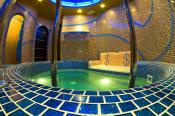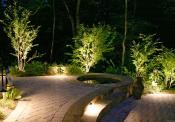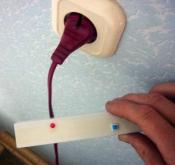Search
Login
Recommended
What to build a greenhouse, tips and comparison
The best way to strengthen immunity, get vitamins and minerals is to get vegetables and fruits from your garden. The greenhouse will help to solve this question.
Content
- Choose the shape of the greenhouse
- Polycarbonate greenhouse video
- Glass covering the greenhouse video
- Film coating video
- Greenhouse frame video
- Greenhouse foundation
- Mitlider aeration of the greenhouse
Choose the shape of the greenhouse
It must be understood that an important step in choosing a greenhouse is its shape.
If you decide to grow tall plants in the greenhouse, the greenhouse is the ideal option (with a gable roof). Depending on the size of the greenhouse itself, the angle of the roof slope is 25-30 degrees.
The second variant of the shape of the greenhouse is arched. Such a greenhouse, requires less materials for coating, the absence of sharp corners, simplifies installation of the coating, extends the service life.
A simplified version of the greenhouse, in which there are no doors, is a tunnel.
If you want to save on building materials and heating, you can build a wall-mounted (single-pitch) greenhouse. But in such a structure there will be less light, there is a danger of the destruction of this greenhouse in winter, due to the snow falling from the roof of the house.
Polycarbonate greenhouse
Widespread, when covering the greenhouse, received cellular polycarbonate.
This material is several times more expensive than glass, but the costs will be justified, as it will last much longer.
The initial translucency of this material is 87%, for 10 years of operation, translucency falls by only 2%.
This lightweight, modern material is lightweight polymer panels with internal longitudinal air cavities.
Polycarbonate can be rolled up, it does not break during drilling and cutting, it is not inferior to double glazing.
polycarbonate advantage
The service life of polycarbonate is 10 years.
It has high light transmission, the highest rate for transparent sheets.
The impact resistance of polycarbonate is very high, almost 20 times greater than that of glass.
The material is very flexible, has excellent thermal insulation properties.
Due to the lightness of the material, you can save on the frame and foundation.
Polycarbonate is protected by sunlight from the film, which extends the service life.
This material must be secured with a protective film to the outside, since the film is applied on only one side.
It is necessary to determine the front side of cellular polycarbonate before installation.
To facilitate the determination of the front side, the manufacturer usually applies a color protective film with information, a sticker or laser marking.
The advantage of polycarbonate is its resistance to the effects of pesticides, it is not combustible.
polycarbonate flaws
Under the influence of high temperatures, this material has thermal expansion, i.e. at high temperatures, the sheets become larger and this must be taken into account when attaching polycarbonate.
Fasten the polycarbonate sheets, be sure to use a rubber gasket, the diameter of the holes for the fastener should be 2 mm. larger than the diameter of the screw itself.
This is called thermal clearance.
Polycarbonate structures are subject to mechanical damage, so greenhouses cannot be cleaned of snow and ice with sharp objects.
You can store polycarbonate only in a horizontal position, in no case do not leave sheets twisted into rolls for a long time and do not put them on the edge.
Installation of polycarbonate sheets should be carried out using specially manufactured components for this.
In the case of joining sheets with each other, apply H-shaped profiles, at the ends of the U-shaped profiles. The service life of your structure depends on the correct assembly.
Tip. Wash polycarbonate with a soft cloth, add soap or detergent to the water. Before using the detergent, be sure to read the composition for the presence of aggressive elements, such as: ammonia, alkali, chlorine. These substances are not acceptable for use in washing polycarbonate. You can recommend using Fairy.
Glass covering the greenhouse
Glass - the material is heavy, brittle, the cost of installing such a greenhouse will be large so that the glass does not crack - a solid foundation is needed.
The advantage of such a greenhouse is that the ground is not covered with snow, freezes less, thaws faster.
Glass has a high light transmittance.
A glass greenhouse, beautifully shaped, will decorate the site.
glass advantage
For growing plants, a glass greenhouse creates the very best microclimate.
Glass is practically not affected by chemicals and pesticides, has a long service life with proper operation.
Even after many years of use, glass does not lose its light transmission.
glass flaws
It requires a solid foundation, and this is a rather expensive and time-consuming process.
The fragility of the material and its large weight requires careful installation.
Have to periodically change broken glass. The shape of the greenhouse can only be in the form of a gable house or an attached gable.
Film coating
Film-covered greenhouses are lightweight, warm up faster and do not require a foundation.
Often greenhouses are covered with a greenhouse film.
This material is made of polyethylene, cheap, easy to cut and assemble, provides protection against frost up to -2 degrees Celsius.
PVC film surpasses polyethylene in strength, avoids burns to plants, as it contains a light stabilizing additive, protects against frost, extends shelf life up to 4 years, and creates a good greenhouse effect.
Reinforced plastic film, thanks to the inner reinforced mesh, can withstand strong gusts of wind and even hail.
It is more expensive, but also lasts longer, reduces the ripening of the crop by 1.5-2 weeks.
A multilayer polymer air bubble film has become widespread in Russia recently.
Between the layers has dry air bubbles that are hermetically sealed - this allows to reduce heat transfer by 4-5 times, compared with single-layer covering materials.
film coating advantage
Such coatings have a low cost, they are easy to install, since fastening is carried out using conventional clamps.
Due to its light weight and small volume, transportation of materials can be carried out in a passenger car.
There are films with enhanced characteristics: heat-saving, light-converting, with anti-condensation effect, etc.
The disadvantages of film coating
The main disadvantage is a short service life: polyethylene - 1 year, reinforced - up to 3 years, PVC - up to 4 years.
Under the influence of the atmosphere, they quickly lose strength and frost resistance.
Polyethylene and PVC films tear very quickly, even due to weak mechanical stress.
Due to the frequent change of cover, this greenhouse will cost you more than structures made of other materials.
Greenhouse frame
For greenhouses with a small area, a lightweight duralumin frame is well suited.
This material is durable, ductile, corrosion resistant, easy to drill and saw. But this frame can be prey for non-ferrous metal hunters.
Greenhouses from a steel corner are considered durable and reliable. Their disadvantages are high thermal conductivity, the tendency of metal to corrosion.
Greenhouses with a wooden frame, when properly processed, last about 5 years, almost as much as metal.
It must be remembered that a tree can be protected with biological agents, they are harmless to humans and plants.
Do not use compounds intended for external processing of wood.
A greenhouse with a frame made of PVC pipes does not rust and does not rot, does not require a foundation and will last for more than a dozen years.
Greenhouse foundation
The foundation for the greenhouse is spot on the poles and tape.
Masonry or concrete strip masonry is preferred.
The foundation must necessarily evenly distribute the load of the entire greenhouse, be located exactly horizontally and divert rainwater.
Between the foundation and the frame, additional sealing is necessary, it will protect the frame from decay and corrosion.
Mitlider aeration of the greenhouse
Ventilate the greenhouse in two ways: draft and swirl.
In the case of draft ventilation, fresh air enters through open frogs or doors located at the end of the greenhouse.
The vortex airing method was developed by Dr. Jack Mitlider.
The ventilation system of such greenhouses is a series of window leaves placed on the roof and located along the entire length of the greenhouse. Such structures are one of the most popular in the whole world.
Modern greenhouses, the installation of which uses the Mitlider method, are covered with polycarbonate, and the windows are equipped with a lever system.
Since the vents are at the top, hot air takes away excess moisture, water condensation does not form on the walls and the temperature in any place becomes almost the same.
Tip. Whichever greenhouse you choose, the main success factor will be the right place for it.
Remember - the greenhouse should be well lit by the sun throughout the day.





